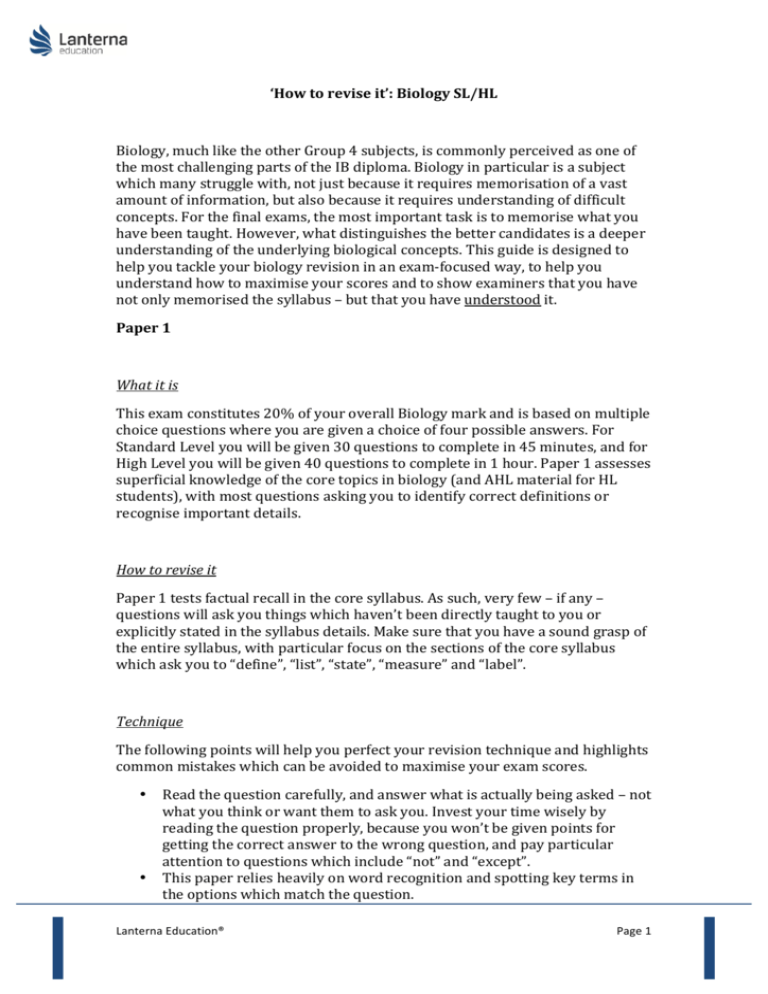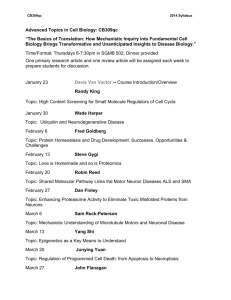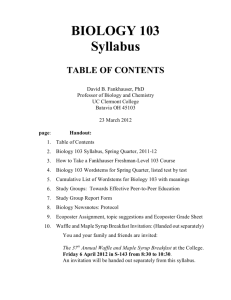IB Revision Skills Guide – Biology
advertisement

‘How to revise it’: Biology SL/HL Biology, much like the other Group 4 subjects, is commonly perceived as one of the most challenging parts of the IB diploma. Biology in particular is a subject which many struggle with, not just because it requires memorisation of a vast amount of information, but also because it requires understanding of difficult concepts. For the final exams, the most important task is to memorise what you have been taught. However, what distinguishes the better candidates is a deeper understanding of the underlying biological concepts. This guide is designed to help you tackle your biology revision in an exam-­‐focused way, to help you understand how to maximise your scores and to show examiners that you have not only memorised the syllabus – but that you have understood it. Paper 1 What it is This exam constitutes 20% of your overall Biology mark and is based on multiple choice questions where you are given a choice of four possible answers. For Standard Level you will be given 30 questions to complete in 45 minutes, and for High Level you will be given 40 questions to complete in 1 hour. Paper 1 assesses superficial knowledge of the core topics in biology (and AHL material for HL students), with most questions asking you to identify correct definitions or recognise important details. How to revise it Paper 1 tests factual recall in the core syllabus. As such, very few – if any – questions will ask you things which haven’t been directly taught to you or explicitly stated in the syllabus details. Make sure that you have a sound grasp of the entire syllabus, with particular focus on the sections of the core syllabus which ask you to “define”, “list”, “state”, “measure” and “label”. Technique The following points will help you perfect your revision technique and highlights common mistakes which can be avoided to maximise your exam scores. • • Read the question carefully, and answer what is actually being asked – not what you think or want them to ask you. Invest your time wisely by reading the question properly, because you won’t be given points for getting the correct answer to the wrong question, and pay particular attention to questions which include “not” and “except”. This paper relies heavily on word recognition and spotting key terms in the options which match the question. Lanterna Education® Page 1 -­‐ For example: • You are asked to recognise the correct definition of osmosis from four options. • One is the correct definition of osmosis (“The passive movement of water molecules, across a partially permeable membrane, from a region of lower solute concentration to a region of higher solute concentration”), • Another is the definition for diffusion (“The passive movement of particles from a region of high concentration to a region of low concentration”). Here, word recognition is key; osmosis is the movement of water, not just particles – and hence you can immediately eliminate the definition for diffusion in this way. Another way to spot the right answer is the direction of movement (low solute concentration to high solute concentration vs high concentration to low concentration). • Read ALL of the options before choosing one. If you are unsure, try to eliminate answers which are obviously wrong to narrow down the possibilities. Remember that time is limited so if you don’t know the answer, don’t spend ages on it – circle the question and come back to it. Once you’ve finished the paper, go back and answer the circled questions. If you still don’t have a better idea of which to choose, just guess – marks are not deducted for wrong answers. Practice The best way to prepare for this paper is to: 1) Feel comfortable with the key concepts and facts in the core syllabus 2) Practice with past exams and the quizzes which can often be found at the back of IB Biology books. Paper 1 top tips • • Read the syllabus details. As Paper 1 covers Objectives 1 and 2, a lot of what you need to know for this paper will often be stated under ‘Teacher’s notes’. Practice makes perfect. Time yourself as you’re doing past papers, and give yourself less time to finish them than you will have for the actual exam. So if you’re doing Biology HL – give yourself 45 minutes to complete 40 questions, if you’re on SL – finish it in 30 minutes. With each paper, you will notice that you become much more confident in answering these types of questions. Eventually you will find that all you can go on ‘autopilot’, noting the key words, and spot the right answer immediately. Practicing with past papers is the best way to get a feel for what level of questions you can expect in your exam – and it’s no secret Lanterna Education® Page 2 that the IBO like to repeat questions, so if anything practicing can just help boost your confidence and keep those nerves in check for the big day! Paper 2 and 3 What it is Paper 2 and Paper 3 are structured in much the same way but test different parts of your syllabus. • • Paper 2: Paper 2 tests knowledge of the core for SL students, and the core and AHL material for HL students. This paper assesses more comprehensive knowledge and understanding than Paper 1, and constitutes 32% of your overall mark for biology and is thus the single most important assessment in your biology course. As such, it is worth investing a considerable amount of preparation for this paper. It is divided into two parts: Section A: here you will be given one data-­‐based question and several short answer questions on the core topics. HL patients will be given questions on AHL topics in addition to the core. All of these questions are compulsory. Section B: here, SL students will be given one extended-­‐response question on the core (from a choice of three). HL students will be given two extended-­‐response questions on the core and AHL (from a choice of four). Paper 3: for SL students, this paper is composed of several short-­‐answer questions in each of the two options studied. HL students have in addition one extended-­‐response question in each of the two options studied. All questions are compulsory. This paper tests knowledge in much the same fashion as Paper 2, except it is based on the syllabus for the two options studied. How to revise it For many students, these papers are the most challenging because they assess deeper understanding of the concepts in biology, rather than simple factual recall. A common misconception about biology is that it is simply memorisation of a lot of facts. Paper 2 and 3 will prove you wrong, because committing the entire biology syllabus to memory will only get you half-­‐way. In fact, half of all the questions in these papers will be based on more complex ideas and require you to use your knowledge of the syllabus to develop an answer which probably hasn’t been taught to you. This may sound daunting to you, but again – practicing with past exams is crucial! Lanterna Education® Page 3 Make sure that you are familiar with the command terms for IB biology (see your syllabus details). Every question in the exam will start out with one of these words which will tell you what to do. If asked to “describe”, give a detailed account, and if asked to “outline” just give a brief account or summary, highlighting key points. It’s worth spending some time going over what the command terms really mean, to avoid spending time writing out an elaborate answer on a very simple question, which won’t give you extra marks but will just waste precious exam time. Technique Like with Paper 1, the first step in approaching the question is making sure you understand what is being asked (pay attention to key words), and how they would like you to give your answer (what’s the command term?). The two types of questions you will get in these papers are: • • Structured questions These questions are organised by topic and are broken up into small sections. Pay particular attention to the number of points allocated to each question – this tells you how detailed your answer needs to be to gain full marks. As always, time is limited – so make sure you spend this time well. If you are unsure of the answer, circle it and come back to it later. Many questions involve data analysis which requires you to interpret a graph or table. Study the data very carefully and pay particular attention to scales, labelling of the graph and its axes. From the data provided, you may be asked to draw conclusions which haven’t been directly taught to you. In these instances, you have to pick out your knowledge of the relevant concepts from the syllabus, and give it your best informed guess based on the data you are given. If asked to calculate, remember to show your working, and give units with your answer. Free response questions: These questions require long and detailed answers. -­‐ It is advisable to write these answers in continuous prose, although sometimes ideas are better demonstrated in a table or in a thoroughly annotated diagram. -­‐ You may be given the option to choose the question you want to answer. Here, it is vital that you read the whole question before choosing which one to answer, to make sure you pick the one where you’re likely to pick the most points. -­‐ Plan out your essay on a piece of scrap paper and organise your ideas to include all the relevant information in a logical sequence. -­‐ There will also be 2 extra marks for quality of construction of your answer, so make sure that you practice writing out longer answers in a logical and coherent manner. Ask your teacher or a fellow student to read your answer and tell you what they understood. Lanterna Education® Page 4 Practice • • The best way to prepare for data analysis questions is by practicing doing them over and over. Past exam questions and the quizzes in various IB biology books are particularly helpful. In addition, try online IB quizzes, and practice interpreting any graph/diagram you come across to become more comfortable with these types of questions. Biology can be very detailed and it can be difficult to know how much to include in your answer, especially under time pressure. For short essay questions, doing past exams and having someone mark them, will show you exactly the level of detail required and can save you loads of precious time. Questions are frequently repeated, and it’s helpful to note what you need and need not include. E.g. in an 8 point question asking you to describe photosynthesis, there will be 8 key pieces of information that the examiners can give you points for. If the same question (or a similar one) pops up in your exam, you can simply recycle these key 8 points and gain full marks! Paper 2 and 3 top tips • • • • Pay particular attention to the sections of the syllabus marked as ‘Objective 3’ – these bear particular emphasis in Paper 2 and 3. Make sure that you understand the key concepts of the syllabus (e.g. more complex ideas such as natural selection, photosynthesis, and cell respiration). Ask teachers, tutors and peers to explain if anything is unclear. Once you feel comfortable about these concepts, try to explain them to someone else – teaching others will help your learning and identify gaps in your knowledge. Study the graphs and diagrams in various biology textbooks/websites and try to interpret them. Share these with your teacher and your peers and ask them to interpret the same diagram. This way you can compare your interpretation to theirs and learn from them. Lanterna Education® Page 5








